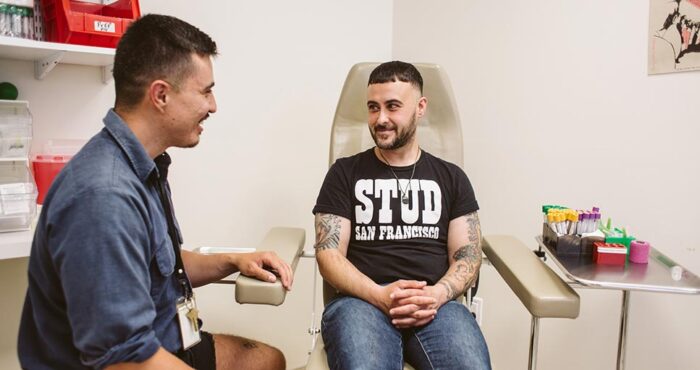Without causing alarm, we’d like you to know about a sexually transmitted infection (STI) you probably haven’t heard about but that we’re seeing in people who visit our sexual health clinic Magnet at San Francisco AIDS Foundation. Although the infection Mycoplasma genitalium itself isn’t new, awareness about and testing for this infection is recently on our radar. Here’s what to know.
What is Mycoplasma Genitalium?
Mycoplasma genitalium (we’ll shorten it to MG) is a bacterial infection that can cause symptoms similar to chlamydia. You can get an MG infection in your urethra (penis), vagina and front hole, rectum (butt), and likely in your throat–although there is only testing available for urethral or vaginal infections.
What are symptoms of MG?
Many people don’t get symptoms from an MG infection. If you do have symptoms, they might include burning, stinging or pain when you pee or discharge from your penis. For people with a vagina or front hole, symptoms might include pain or bleeding during sex, pain in your pelvic area, bleeding between periods, and discharge from your vagina or front hole.
How is MG diagnosed?
We diagnose MG by talking to you about your symptoms and sexual history, doing a physical exam, and testing your urine or doing a vaginal swab.
Should you get tested for MG?
If you still have symptoms mentioned above after treatment for gonorrhea and chlamydia, testing of MG may be appropriate. At this time, we are not recommending that people without symptoms get tested for MG. As always, we recommend regular testing for other STIs (gonorrhea, chlamydia and syphilis) even if you don’t have symptoms.
Health care providers might not consider or test for MG infection. So the important thing to know is that if you have symptoms of an STI in your penis, vagina, or front hole, get tested and treated. If you still have symptoms after treatment you might have MG.
If you think you have an MG infection, ask your provider if testing is available for MG, or make an appointment at Magnet if you are in the San Francisco Bay Area.
About MG testing
Testing for MG is done through a urine sample or swab. Once a sample is taken, it is analyzed by a lab for the presence of MG bacteria using the same type of DNA tests that we use for gonorrhea and chlamydia. Usually, it takes 3-5 days for you to find out your result from an MG test.
What is the treatment for MG?
The antibiotic azithromycin can treat MG. About 50% of cases are resistant to azithromycin, which means that the medication won’t cure the infection and you would still have symptoms. In these cases, we use a second type of antibiotic (Moxifloxacin) which requires 7 – 10 days of medication.
Should my partner(s) get tested for MG?
If your partner(s) are experiencing any symptoms, it’s a good idea for them to get tested for STIs. At this time, we don’t recommend that people without symptoms get tested for MG.
Resources
Symptoms of an STI?
If you have symptoms of a suspected STI, call our sexual health clinic in the Castro at 415-437-1600.
Tell Your Partner
It takes less than 2 minutes to notify your partners that they may have been exposed to an STI. Find out more about Tell Your Partners, explore the Tell Your Partner website to notify sex partners, find a local free clinic and get tips on talking to sex partners in person.









